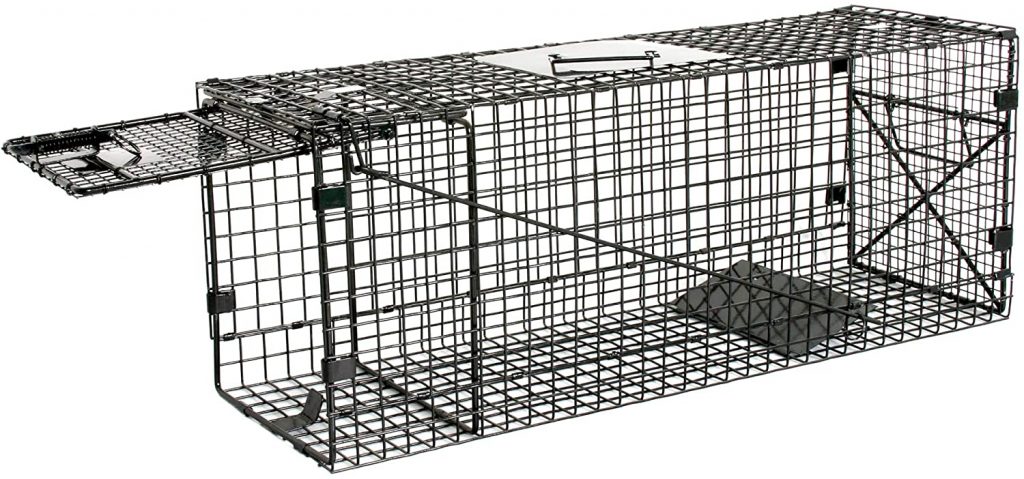Last updated on February 6th, 2023 at 12:15 am

A feral cat is a homeless cat who has never been tamed and has lived most of its life in the wild. These cats have little contact with people. If they did, it might not have been pleasant. They tend to fear or shy away from people and might turn aggressive if being approached. When you find a feral cat that you like and want to take it home, you must know the right techniques to catch it. You will need to follow several procedures when trapping cats to protect your well-being and the cat’s. Dive into this article to find out more on different techniques to catch a feral cat and how to tame it.
Techniques to catch a feral cat
1. Use a camouflaged trap
Feral cats are more likely to enter a trap box if it looks like a natural element of the environment. Burlap should be draped over the trap’s top, sides, and floor to conceal it when working in a woody or grassy area. The cat should be able to enter the box unhindered and have a clear look out at the back when the front and back doors are left open. Spread the burlap with sticks, leaves, and other loose organic materials. To make the trap seem even more natural, try to place it close to a bush or beneath a tree if probable. Other environments can also benefit from the use of similar strategies.
2. Utilize a rear door that is see-through
A cat is less afraid to enter the small spaces of a box trap if she thinks there is an exit on the other side. A transparent back door is one way to give the image of a rear exit. Request that a part of thick Plexiglass be cut to the proper size at your neighborhood store if you’re using this technique. The door should have a hole near the center top, and after that, you should use a sturdy twist or cable tie knot to attach the transparent door to your trap. When you’ve finally captured your mysterious cat, take her into a separate area at the front of the trap using a trap divider before switching out your transparent door for a regular one.
3. Incorporate a drop trap
Because most cats have a natural aversion to going into a normal trap, you must deprive them of food the previous day and wait until they are ravenous before attempting to capture them. Some cats may refuse to eat also after going without food for a day; a drop trap would be ideal for these cats. Cats are less hesitant to enter a drop trap than a box trap. Therefore, a drop trap will work for the majority of unattainable felines.
4. Teach the cat to go in the trap
It is possible to teach a cat to enter a trap by leaving it outdoors in its territory for a long time. A secure location is required, such as a secluded backyard or a gated courtyard, to ensure that nobody steals the equipment from there. You can train a complete colony with this technique and one trap for each cat. Put the trap’s front entrance in an elevated position and secure it and set the trap close to the cat’s regular feeding area in its territory. Please keep it in position all through the training. The cat’s regular meal should be placed on the ground a foot or 2 from the front door of your trap on the initial training day. If the cat isn’t eating it, keep placing the plate on that spot, the same range from your trap. Continue doing this till the plate is directly in front of your trap. Transfer the plate a couple of inches within the trap once the cat is at ease eating from there. Untie or open the front entryway on the day you’ve scheduled to set the trap; during the time the cat typically eats, bait your trap, and place the trigger.
5. Draw the cat to an enclosed area
You’re well on getting a cat into a trap when you can get it into an enclosed area like a garage, shed, or basement, then shut the door behind it. Ensure that no windows are open, gaps in the wall, or potential escape ways by checking in advance. Place a huge board against the wall and hide your trap behind the board. Place food inside the trap to lure the cat in. Once the cat is inside the area, it will eventually find a place to hide. Ensure that there are no other hiding spaces, and the only place for the cat to hide is to go behind the board where you have set up the trap.
6. Use of Phone
Sometimes, the cat is unwilling to enter the trap, and this is when your phone can be a great help. Play meowing sounds on your phone to deceive the cat into thinking that there is another cat or kitten somewhere. Place the phone at the back of the trap. The cat will enter the trap, trying to access the place where the meowing sound is coming from.

How to tame a feral cat
Take the cat for inspection
Once you catch the cat, immediately cover the trap with a towel to help calm the cat down then take the cat to the veterinarian. In addition to having fleas and other conditions, feral cats often hold diseases. Have these issues taken care of on the cat before taking it home. Ensure that you do not touch it.
Put the cat in a prepared confined area
Inside the confined area, ensure bedding, water, food dishes, and a litter box. Make sure that the box is far from other pets and also your family. Leave it in the box for about two days and ensure they cannot run away.
Give the feral cat more space
Spend some time around the carrier and use smooth tones to get the cat to be calm and familiar with your voice. Once it is calm and familiar to you, you can now let it out of the cage. It would be best if you did not force it to get out of the cage and make sure that you get the cat a place where it can hide.
Give the cat treats
Stay in the room for a while for the cat to get used to you, and you can use snacks to draw their attention. Stay at the same level closer to the cat and wait as they are familiar with the environment. Avoid making eye contact as the cat may take it as a threat.
Coax the cat through hunger advantage
Switch up how you feed them and carry any bowl with food left away. When seeing the cat, this is the best time to serve it. However, this is not an excuse to starve the cat.
Go towards the cat, then pick it up
When a few days pass, you can start picking them up as they are more at ease and come towards you for food and treats. If they are aggressive, try this another day, and do not force the cat.
Make time to play with your cat daily
The last part of the taming period can last more than a month. Keep working with the cat until it no longer exhibits fear or has any problem being handled and petted. Eventually, the cat should feel comfortable being handled.
Stay with the cat or give it to a rescue center
The cat is prepared for a typical domestic life after the taming phase. You might choose to give the cat away to a cat shelter or decide to keep it in your home. Make sure to neuter or spay the cat if you intend to keep it.
Things to avoid when you try to catch a feral cat
- Please refrain from attempting to use your hands to hold the cat. The friendliest cat can become frightened when being grabbed, and it may bite or scratch you. If the cat tries to flee from you, you could also cause harm to it.
- Do not quit. Be clever, persistent, and patient. You’ll manage to lure that cat into entering the trap if you keep trying.
- Make sure that your trapping equipment is designed for trapping cats. Alternate trapping techniques could result in a cat being hurt or even killed.
- Avoid holding back water and food for over 2 days. It won’t aid your efforts to set traps. The well-being and health of cats can be harmed instead.
Conclusion
Catching a feral cat is not a walk in the park. Taming and training the cat is not easy neither. You will have to be patient. It is also important to remember that feral cats might be aggressive and hostile. I hope this article will be helpful to you as you consider taming or trying to catch a feral cat.
Additional Resources:
Why Is Your Cat Looking Out The Window?
When Cats Rub Against You, What Does It Mean?


